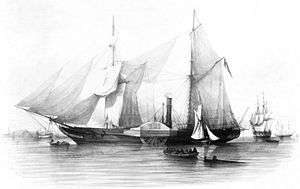HMS Gorgon (1837)
 HMS Gorgon by Sir Oswald Walters Brierly. | |
| History | |
|---|---|
| Name: | HMS Gorgon |
| Ordered: | 10 July 1834[1] |
| Builder: | Royal Dockyard, Pembroke Dock[2] |
| Laid down: | July 1836[1] |
| Launched: | 31 August 1837 |
| Commissioned: | 30 August 1838[1] |
| Decommissioned: | 11 February 1864 |
| Fate: | Sold for breaking on 17 October 1864[1] |
| General characteristics | |
| Type: | Steam vessel (later, first-class sloop) |
| Displacement: | 1,610 long tons (1,640 t) |
| Tons burthen: | 1108 67/94 bm[1] |
| Length: |
|
| Beam: | 37 ft 6 in (11.4 m) |
| Draught: | 16 ft (4.9 m)[3] |
| Depth of hold: | 23 ft (7.0 m)[1] |
| Installed power: | 800 ihp (600 kW)[1] |
| Propulsion: |
|
| Sail plan: | Schooner (later brig)[1] |
| Speed: | 9.5 kn (17.6 km/h)[1] |
| Complement: | 160 |
| Armament: |
|
HMS Gorgon was a wooden steam paddle sloop of 6 guns, launched in 1837. In 1840 she took part in the bombardment of Acre, and in 1843 was part of the Royal Navy squadron stationed in the River Plate during the Uruguayan Civil War. She was converted to a troopship and in 1858 assisted Agamemnon in the laying of the first transatlantic telegraph cable. She was sold for breaking in 1864.
Design and construction
Gorgon was designed by Sir William Symonds and was the first vessel to be fitted with direct-acting engines (in which the engine's cylinders are placed under the crankshaft), the engines being built by Seaward and Company. In addition to saving space over previous side-lever engines, they weighed 60 tons less. She was teak built with oak main beams, had a displacement of 1,610 long tons (1,640 t), and her paddle wheels were 27 feet (8.2 m) in diameter. She was laid down at Pembroke Royal Dockyard in July 1836 and launched on 31 August 1837.[1]
Service
In 1840 Gorgon saw action with three other paddle sloops, Vesuvius, Stromboli and Phoenix, in the bombardment of the city of Acre under the command of Admiral Robert Stopford. At the height of the battle either Gorgon or her sister ship HMS Benbow fired the shell that destroyed Acre's powder magazine, causing an explosion that greatly weakened the city's defences.[4]
In 1843, during the Uruguayan Civil War, Gorgon arrived in the River Plate to join the Royal Navy squadron commanded by Commodore John Purvis. She anchored in the bay as a deterrent to potential attackers. She ran aground on 10 May 1844 but was subsequently refloated.
From 23 February 1854 to 8 May 1854 Gorgon was commanded by Commander (and Captain) Arthur Cumming.[5]
From August 1856-June 1857 HMS Gorgon was at Boudroum (modern Bodrum) under Captain George William Towsey, commissioned to transport the finds from Sir Charles Thomas Newton's excavation at the Mausoleum of Halikarnassos to the British Museum.[6]
In 1858 Gorgon assisted in the laying of the first transatlantic telegraph cable by taking soundings for the former warship HMS Agamemnon, which had been converted into a cable ship. When the cable link was completed to New York, the crew of the Gorgon and the other ships were feted by civic receptions and processions through the city.[7]
Gorgon was despatched to Madagascar in 1863 to keep the peace on the death of King Radama II.[8] She returned via the Cape of Good Hope, arriving at Spithead on 29 January 1864. She discharged her ammunition and guns at the Royal Arsenal, was paid out of commission on 11 February.[9]
Despite being decommissioned, Gorgon had one last mission. The vessel was towed to Greenhithe on 6 May 1864 to act as a receiving hulk for the crew of HMS Osborne, seven of whom had acquired smallpox.[10] The ship was ultimately dismantled at Woolwich.[11] She was sold to Charlton for breaking on 17 October 1864.[1]
References
- 1 2 3 4 5 6 7 8 9 10 11 12 Winfield, p.159
- ↑ The Times (London), Tuesday, 19 September 1837, p.1
- ↑ The Times (London), Monday, 23 May 1859, p.11
- ↑ Kahanov 2014, p.152.
- ↑ Davis, Peter. "Captain Authur Cumming RN". Retrieved 8 September 2010.
- ↑ Journals and letters of Sir Charles Thomas Newton, British Museum library
- ↑ The Times of London, Monday, 20 September 1858, p.7
- ↑ The Times (London), Wednesday, 3 February 1864, p.9
- ↑ The Times (London), Thursday, 11 February 1864, p.12
- ↑ The Times (London), Saturday, 7 May 1864, p.9
- ↑ The Times (London), Saturday, 30 January 1864, p.12
Bibliography
- Colledge, J. J.; Warlow, Ben (2006) [1969]. Ships of the Royal Navy: The Complete Record of all Fighting Ships of the Royal Navy (Rev. ed.). London: Chatham Publishing. ISBN 978-1-86176-281-8. OCLC 67375475.
- Cooper Key, Sir Astley (1847), A Narrative of the Recovery of the HMS Gorgon, London: Smith, Elder & Co., ISBN 1-84150-801-2
- Dumpleton, Bernard (2002), The Story Of The Paddle Steamer, Bristol: Intellect Books, p. 174, ISBN 1-84150-801-2
- Kahanov, Yaacov; Stern, Eliezer; Cvikel, Deborah; Me-Bar, Yoav (2014), "Between Shoal and Wall: The naval bombardment of Akko, 1840", The Mariner's Mirror 100 (2): 147 – 167, doi:10.1080/00253359.2014.901699
- Winfield, Rif & Lyon, David (2004). The Sail and Steam Navy List: All the Ships of the Royal Navy 1815–1889. London: Chatham Publishing. ISBN 978-1-86176-032-6. OCLC 52620555.
| ||||||||||